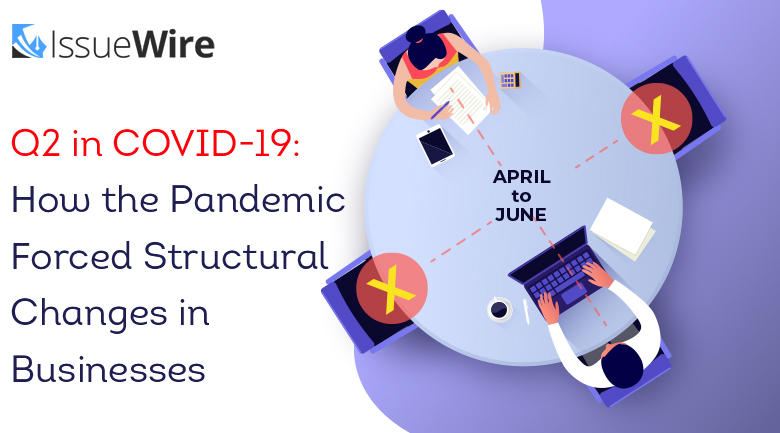Since the worldwide outbreak of Coronavirus in March, businesses have had to restructure their organizations to cope up with the economic crunch over a complete quarter.
Several months have passed and now businesses have closed the chapters on Q2. So, this is the right time to assess the condition of the customers and their relationships with various organizations. What has changed since the declaration of the COVID-19 pandemic on March 11? How have the organizations adapted themselves to the changed economic atmosphere? What has worked for them and what hasn’t? And, what modifications can be used for the betterment of the businesses even after the pandemic?
Current Scenario of Q2
When COVID-19 was declared a pandemic by the WHO, various organizations had to shut down their physical outlets, while businesses with an existing online presence, were set to obtain distinct advantages. Such businesses were already geared up to capitalize on their pre-existing online presence.
Things got a bit complicated when customers began to get engaged with organizations. Marketing and PR teams have been subjected to the challenge of engaging an audience that is always on the web. Emails have witnessed a significant rise in its volume, with open rates witnessing drastic changes.
However, sales have decreased; a study shows, sales teams have sent 60% more emails than the pre-pandemic era. But the response rates haven’t been satisfactory. This is certainly a matter of concern for the companies.
Impact of COVID-19 on Business in Q2
1. Customer Interest
When it comes to customer interest, web traffic can be considered as one of the most significant factors. And, since customers have shifted to online purchasing, web traffic has become the most important factor for organizations. Businesses with an existing online presence have benefitted hugely from it as a study reveals that global web traffic witnessed an increase of 16% in Q2 compared to Q1. It was at a peak during the third week of April, reaching 24% above the standard benchmark. The construction industry and computer software industry witnessed the most increase in their web traffic during this period.
With the companies shifting to remote settings, sales teams are forced to rely heavily on chat windows. Chat volume was at its peak in late-May, reaching 45% above the standard benchmark. The chat volume of Q2 was 31% above Q1. With restrictions being lifted from businesses across the world, it will be pretty exciting to see the growth or decline of the chat volume in the future. Every industry has surpassed the benchmark in terms of live customer chatting, which is a positive sign for companies. As this reflects the interest of consumers in purchasing more frequently; construction, human resources, consumer goods, and manufacturing industries witness a growth of 25% in the last quarter.
2. Consumer Engagement
Email marketing witnessed a heavy increase during the second week of March and stayed at this level throughout the second quarter. 21% more emails were sent during Q2 compared to Q1 and it peaked at 36% above the standard benchmark in mid-June. This showcases the ability of the marketing teams that have helped in the growth of their companies. It is also interesting to see that in Q2 companies with 0-25 employees rose 31%, companies with 26-200 employees rose 21%, and companies with over 201 employees rose 14% than Q1. However, companies with lesser emails sent witnessed higher open rates in Q2. This is because larger companies sent out more emails to their smaller consumer base. Human resources sent out 81% more emails in Q2 than Q1, but the open rates are 4% below the standard benchmark. These facts reflect that companies can use emails to communicate with the customers but shouldn’t overdo it.
Now coming to emails sent by sales teams, it is seen that 42% more emails were sent between early-March and late-April. 44% more emails were sent by sales teams in Q2 compared to Q1. At this moment, the global email volume of sales teams is standing at 59% above the pre-COVID time. The reason for sales emails not being as effective as marketing emails is that customers aren’t being much responsive to the sales emails. As sales teams began sending more emails, irritated customers started marking those as spams, leading to a 24% drop in response rates in Q2. Both construction and consumer goods industries sent out 100% more emails in Q2 than Q1 but the response rates have been 33% lower.
3. Sales Outcomes
Data show that the total number of deals created lowered by 8% during Q2 compared to Q1. This data stayed more or less true for all the industries. However, the scenario has changed in the last few weeks. All industries are growing and slowly reaching the pre-COVID benchmarks. Companies with 200+ employees have witnessed relatively faster growth. Entertainment and travel industries have been the most impacted of all.
Deals won was also 11% lower in Q2 compare to Q1 – however, there were variations across company sizes, industries, and regions. Here, companies with a relatively lower number of employees (0-25) were better at winning deals, as in Q2, they were only 5% below the standard of Q1.
Consequences
Investing in the chat process is one of the most significant ways of getting in touch with consumers. This can be considered as a long-term investment, as businesses will surely carry forward with their online business strategies even after the pandemic.
Both marketing and sales teams need to focus on quality rather than quantity. The response rates of the emails sent out are way low and constantly sending emails to customers, creates a bad impression. This must be neglected at all costs.
It is high time for the companies to start investing more in online tools as this is the future. This worldwide crisis has shown us that the businesses already existing online have been less affected by the global shutdown. Digital platforms are the future and every organization must consider it.








